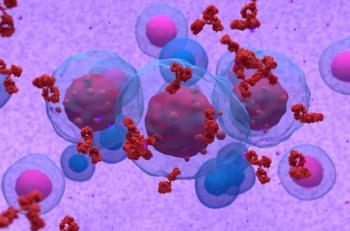
Sorafenib for RCC Well-Tolerated in Older Patients
Results from a retrospective analysis indicate that the use of the antiangiogenic, VEGF inhibitor sorafenib for the treatment of advanced renal cell carcinoma was well tolerated in patients aged 65 years or older.
Results from a retrospective analysis indicate that the use of the antiangiogenic, VEGF inhibitor sorafenib for the treatment of advanced renal cell carcinoma was well tolerated in patients aged 65 years or older.
Ball-and-stick model of sorafenib
Studies have shown that the median age for diagnosis with renal cell carcinoma (RCC) is 64 years. Despite that, older patient populations have been underrepresented in clinical trials of targeted therapies for RCC, according to background information in the article, which was published in the British Journal of Cancer.
“These results suggest that physicians consider the use of sorafenib as a first-line agent in patients with metastatic RCC who are more than 75 years old or frail due to comorbidities,” said Giuseppe Procopio, MD, of the department of medical oncology at Fondazione IRCCS, Milan, Italy.
To examine outcomes in older patients with advanced RCC taking sorafenib, Procopio and colleagues retrospectively examined data from the Sorafenib-RCC Integrated Database. This database includes clinical data from all patients with RCC who were treated with sorafenib in company-sponsored trials, including the more than 40% of patients who were aged 65 years or older.
The researchers looked at dosing patterns in the older patient population and the incidence and prevalence of drug-related adverse events (DREA) and fatal DREA. The database included 1,382 patients aged 65 to 74 years and 559 patients aged 75 years or older.
Data indicated that those patients who were aged 65 to 74 years had a median treatment duration of about 4 to 4.2 months, similar to that of younger patients being treated. However, in the eldest patients, the duration was about 30% shorter.
No substantial differences in DRAEs were found across any of the subgroups examined. The researchers broke down the occurrence of DRAEs by 3-month intervals and found that grade 3 DRAEs occurred most frequently in the first 3 months after treatment began.
Patients aged 75 years or older experienced higher levels of grade 3/4 fatigue compared with younger patients, but also had less hand-foot skin reaction. A slight increase in serious DRAEs was found with increasing age, with patients in the oldest age group experiencing more during the first 6 months of treatment than the other age groups.
Overall, only 0.7% of patients experienced a fatal DRAE.
“The oldest patients were less likely to have previously received nephrectomy and/or cytokines, were treated for slightly shorter time periods, and were more likely to have received dose modifications and/or discontinuations due to DRAEs, particularly early in treatment,” the researchers wrote in their discussion of the results. “These patients were also more likely to remain on a lower dose after dose reduction, rather than be re-escalated to the full dose.”
However, the researchers were missing data on patient performance status, so they could not conclude whether these changes were due to age or greater comorbidities in older patients.
“Physicians should optimize the therapeutic program for patients in a way that coincides with their characteristics, including age, life expectancy, and comorbidities,” Procopio said.
Newsletter
Stay up to date on recent advances in the multidisciplinary approach to cancer.


















































































